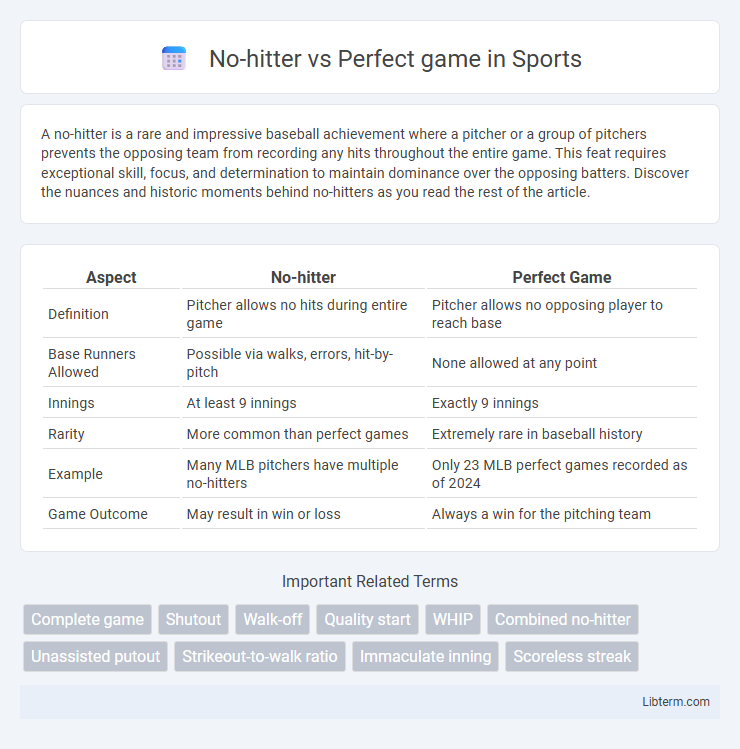A no-hitter is a rare and impressive baseball achievement where a pitcher or a group of pitchers prevents the opposing team from recording any hits throughout the entire game. This feat requires exceptional skill, focus, and determination to maintain dominance over the opposing batters. Discover the nuances and historic moments behind no-hitters as you read the rest of the article.
Table of Comparison
| Aspect | No-hitter | Perfect Game |
|---|---|---|
| Definition | Pitcher allows no hits during entire game | Pitcher allows no opposing player to reach base |
| Base Runners Allowed | Possible via walks, errors, hit-by-pitch | None allowed at any point |
| Innings | At least 9 innings | Exactly 9 innings |
| Rarity | More common than perfect games | Extremely rare in baseball history |
| Example | Many MLB pitchers have multiple no-hitters | Only 23 MLB perfect games recorded as of 2024 |
| Game Outcome | May result in win or loss | Always a win for the pitching team |
Definition of a No-Hitter
A no-hitter is a baseball game in which a pitcher or pitching staff allows no hits over the entire course of at least nine innings, preventing the opposing team from recording a single hit. Unlike a perfect game, a no-hitter may still allow batters to reach base through walks, errors, or hit-by-pitches. This rare pitching achievement demonstrates exceptional skill in limiting the opposing offense's ability to make contact resulting in hits.
What is a Perfect Game?
A Perfect Game in baseball occurs when a pitcher faces the minimum 27 batters in a nine-inning game without allowing any opposing player to reach base. This means no hits, walks, hit batters, or errors that enable a batter to advance, resulting in 27 consecutive outs. A Perfect Game is a rarer and more prestigious achievement than a no-hitter, which only requires that no hits are allowed but may still include walks or errors.
Key Differences Between No-Hitter and Perfect Game
A no-hitter occurs when a pitcher or combination of pitchers allows no hits during the entire game, but batters can still reach base through walks, errors, or hit-by-pitches. A perfect game is a more stringent feat where no opposing player reaches base at all, resulting in 27 consecutive outs without any hits, walks, errors, or hit-by-pitches. The key difference lies in that every batter is retired in a perfect game, whereas a no-hitter permits baserunners under specific circumstances, making perfect games significantly rarer in Major League Baseball history.
Historical Significance in Baseball
A no-hitter in baseball, where a pitcher allows no hits but may permit walks or errors, holds significant historical value as a rare pitching feat demonstrating dominance over opposing batters. A perfect game, which requires retiring all 27 batters consecutively without any reaching base, is even more historically significant and celebrated due to its extreme difficulty and rarity, with only 23 officially recorded in Major League Baseball history as of 2024. Both achievements are milestones that highlight pitching excellence and are etched into baseball lore, greatly impacting the careers of pitchers and the legacy of teams.
Rarity and Frequency of Both Feats
No-hitters occur more frequently than perfect games, with over 300 recorded in MLB history compared to fewer than 25 perfect games. The rarity of perfect games is underscored by the requirement that no opposing player reach base, making it a significantly more challenging feat. While no-hitters demonstrate dominant pitching, perfect games are considered the pinnacle of pitching excellence due to their extreme scarcity and difficulty.
Notable No-Hitter Moments
Notable no-hitter moments in MLB history include Nolan Ryan's record seven no-hitters, with his seventh occurring at age 44, showcasing unparalleled dominance. Don Larsen's perfect game in the 1956 World Series remains the only postseason perfect game, highlighting the rarity between a no-hitter and a perfect game. While a no-hitter allows for walks or errors, perfect games require 27 consecutive outs without baserunners, making Larsen's achievement a distinguished milestone in baseball lore.
Legendary Perfect Games in History
Legendary perfect games in baseball history, such as Don Larsen's 1956 World Series masterpiece and Randy Johnson's 2004 near-flawless performance, stand as rare feats where no opposing batter reaches base. Unlike a no-hitter, which allows for walks, errors, or hit batters as long as no hits are allowed, a perfect game requires retiring all 27 batters consecutively without any reaching base. These flawless pitching performances are celebrated for their rarity and dominance, cementing their iconic status in Major League Baseball lore.
Rules and Official Criteria
A no-hitter occurs when a pitcher or pitching staff prevents the opposing team from achieving any hits throughout a complete game, but batters may reach base via walks, errors, or hit-by-pitches. A perfect game requires that no opposing batter reaches base at all, meaning 27 consecutive outs with no hits, walks, errors, or hit-by-pitches recorded. Official MLB rules recognize only offline games as no-hitters when the game lasts at least nine innings with no hits allowed, while perfect games additionally mandate zero baserunners in that entire span.
Impact on Pitcher’s Legacy
A no-hitter significantly enhances a pitcher's legacy by demonstrating exceptional control and dominance over opposing hitters throughout an entire game. A perfect game, however, represents the pinnacle of pitching achievement, showcasing flawless performance with no opposing batter reaching base, thereby immortalizing the pitcher in baseball history. Achieving either feat cements a pitcher's reputation, but a perfect game carries a rarer and more prestigious impact on their career legacy.
Famous Pitchers Who Achieved Both
Nolan Ryan and Sandy Koufax are two legendary pitchers who have achieved both no-hitters and perfect games, showcasing their dominance on the mound. Ryan holds the MLB record with seven no-hitters, while Koufax threw four no-hitters, including a perfect game in 1965. Their exceptional control and power pitching have solidified their status among the most celebrated figures in baseball history.
No-hitter Infographic

 libterm.com
libterm.com